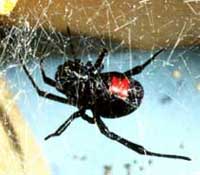|

 Adult female black widow spiders are shiny black with an hourglass
shaped marking on the bottom of its abdomen which, although most
commonly red, may range in color from white to yellow to various
shades of orange and red. They also bear a small, usually red (colors
vary) dot near the spinerettes, which is separate from the hourglass.
In some varieties, the two halves of the hourglass shape may be
separated into two separate dots. A large female black widow spider
can grow to 1.5 inches (38 mm), counting legspan. The body is about
0.5 inches (13 mm). Male black widow spiders are half the size of
the female or smaller. They have longer legs and a smaller abdomen
in relation to their body size. They are also usually dark brown
with varying colors of stripes/dots, with no hourglass mark. Juvenile
black widow spiders start white, molting to dark brown to black
exoskeletons with white, yellow, orange and red stripes and/or dots
on their backs. Adult female black widow spiders are shiny black with an hourglass
shaped marking on the bottom of its abdomen which, although most
commonly red, may range in color from white to yellow to various
shades of orange and red. They also bear a small, usually red (colors
vary) dot near the spinerettes, which is separate from the hourglass.
In some varieties, the two halves of the hourglass shape may be
separated into two separate dots. A large female black widow spider
can grow to 1.5 inches (38 mm), counting legspan. The body is about
0.5 inches (13 mm). Male black widow spiders are half the size of
the female or smaller. They have longer legs and a smaller abdomen
in relation to their body size. They are also usually dark brown
with varying colors of stripes/dots, with no hourglass mark. Juvenile
black widow spiders start white, molting to dark brown to black
exoskeletons with white, yellow, orange and red stripes and/or dots
on their backs.
As with many poisonous creatures, the brightly coloured markings
serve as a warning to predators. Eating a black widow will normally
not kill a small predator (birds, et cetera), but the sickness that
follows digestion is enough for the creature to remember that the
bright red means not to eat.

Prey: Black widow spiders typically prey on a variety of insects, but occasionally they do feed upon woodlice, diplopods, chilopods and other arachnids). When the prey is entangled by the web, L. mactans quickly comes out of its retreat, wraps the prey securely in its strong web, then punctures and poisons its prey . The venom takes about ten minutes to take effect, meanwhile the prey is held tightly by the spider . When movements of the prey cease, digestive enzymes are released into the wound . The black widow spider then carries its prey back to its retreat before feeding.
Enemies: There are various parasites and predators of widow spiders in North America, though apparently none of these have ever been evaluated in terms of augmentation programs for improved biocontrol. Parasites of the egg sacs include the flightless scelionid wasp Baeus latrodecti, and members of the chloropid fly genus Pseudogaurax. Predators of the adult spiders include a few wasps, most notably the blue mud dauber Chalybion californicum, and the spider wasp Tastiotenia festiva. Other species will occasionally and opportunistically take widows as prey, but the preceding all exhibit some significant specific preference for Latrodectus.
Venom: Although their venom is extremely potent, these spiders are not especially large. The actual amount of venom injected by a bite is very small in physical volume. When this small amount of venom is diffused throughout the body of a healthy, mature human, it usually does not amount to a fatal dose. Deaths in healthy adults from black widow bites are relatively rare in terms of the number of bites per thousand people.
Human Deaths: Only sixty-three deaths were reported in the United States between 1950 and 1989. On the other hand, the geographical range of the widow spiders is very great. As a result, far more people are exposed, world-wide, to widow bites than are exposed to bites of more dangerous spiders, so the highest number of deaths world-wide are caused by members of their genus. Widow spiders have more potent venom than most spiders, and 5% of reported bites result in fatalities.
Venom action: Black widow venom spreads rapidly throughout the body and acts by causing the release of the neurotransmitter acetylcholine, which is involved in muscular contraction. Once in the blood, the toxin is moved by the circulation and deposited in the nerve ends where they insert into the muscle. Most strongly affected are back, abdomen, and thigh muscle areas. The venom acts at the nerve ends to prevent relaxation of the muscle, causing tetany - or constant, strong, painful contractions of the muscles. Standard treatments usually involve symptomatic therapy with pain medication, muscle relaxants, and, rarely, antivenin. The venom does not typically cause problems at the bite site itself, unless a secondary skin infection occurs.

Currently, there are three recognized species of black widow found in North America: The southern black widow (L. mactans), the northern black widow (L. variolus), and the western black widow (L. hesperus). As the name indicates, the southern widow is primarily found (and is indigenous to) the southeastern United States, ranging from Florida to New York, and west to Texas and Oklahoma. Specimens have been found further west as well. The northern widow is found primarily in the northeastern US and southeastern Canada, though its ranges overlap that of L. mactans quite a bit. The western widow is found in the western half of the United States, as well as in southwestern Canada and much of Mexico.
All text is available under the terms
of the GNU Free Documentation License
|

